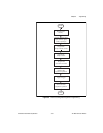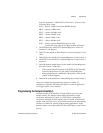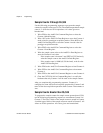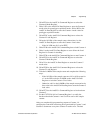
Chapter 5 Programming
©
National Instruments Corporation 5-21 AT-MIO-16X User Manual
7. Entries stored in the mux-channel gain memory should be scanned
once during a scan interval. The following condition must be
satisfied:
scan interval ≥ sample interval
*
x, where x is the number of entries
in the scan sequence.
Write the desired scan interval to the Am9513A Data Register to
store the Counter 2 load value:
– If the scan interval is between 2 and FFFF (65,535 decimal),
write the scan interval to the Am9513A Data Register.
– If the scan interval is 10000 (65,536 decimal), write 0 to the
Am9513A Data Register.
8. Write FF22 to the Am9513A Command Register to arm Counter 2.
After you complete this programming sequence, Counter 2 is
configured to assign a time interval to scan sequences once the trigger
to enable A/D conversions is detected.
Applying a Trigger
Once a data acquisition operation has been configured and
programmed, the acquisition sequence is initiated when a trigger is
received. A trigger can be initiated through software or hardware.
To initiate the data acquisition operation through software, strobe the
Start DAQ Register. Make sure EXTTRIG* is not pulled low at the I/O
connector or the RTSI switch.
To initiate the data acquisition operation through hardware, apply an
active low pulse to the EXTTRIG* pin on the AT-MIO-16X I/O
connector. See the Timing Connections for Data Acquisition and
Analog Output section in Chapter 2, Configuration and Installation,
for EXTTRIG* signal specifications.
Once the trigger is applied, Counter 3 generates pulses initiating A/D
conversions once every sample interval until the sample counter
reaches zero. In the pretrigger mode, these conversions are not counted
by the sample counter. Counting begins only after the application of a
second hardware or software trigger condition and continues until the
sample counter reaches zero. A/D conversion data stored before receipt
of the EXTTRIG* or DAQ Start signal are pretrigger samples.


















